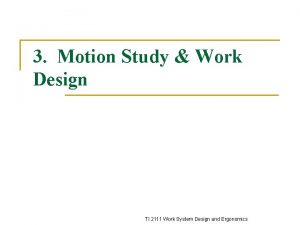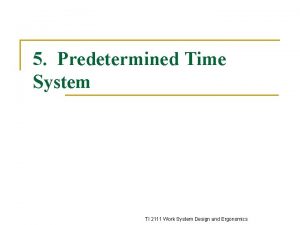6 Work Sampling TI 2111 Work System Design








- Slides: 8

6. Work Sampling TI 2111 Work System Design and Ergonomics

Study Plans (Protocol) n n n n Define the problem; what data should be collected, which forms should be prepared Start with preliminary estimate of the variable. This can be historical data, conducting pilot study, or an educated guess (least desirable) Determine the desired accuracy of the results (confidence interval) Estimate the # of observations Develop a sampling schedule Design the data collection form, and control charts if applicable Perform the study Analyze the results TI 2111 Work System Design and Ergonomics

Technique n n n Locate yourself at the same place each time prior to observing the operation Try to intentionally distract yourself from the variable of observation as you approach the site Limit your time at the site to that actually needed for the observation TI 2111 Work System Design and Ergonomics

Technique (con’t) n n Try to record only the minimum data that you will need to successfully reconstruct the observation Verify any discrepancy with the supervisor Make notes on the form after the operator can no longer see you Keep a pleasant attitude TI 2111 Work System Design and Ergonomics

TI 2111 Work System Design and Ergonomics

Every time observation is collected, the analyst draws the picture as is to the form (the time the observation is taken is redundant): TI 2111 Work System Design and Ergonomics

Determining Sample Size n The basic equation Where n = number of observations needed z = number of standard deviations required for a specific confident level P = percentage of time spent on an element A = accuracy desired (expressed as a E%) TI 2111 Work System Design and Ergonomics

Randomly Scheduling Observations n n Table lookup Randomly generated times TI 2111 Work System Design and Ergonomics














